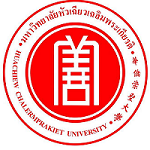กรุณาใช้ตัวระบุนี้เพื่ออ้างอิงหรือเชื่อมต่อรายการนี้:
https://has.hcu.ac.th/jspui/handle/123456789/3049| ชื่อเรื่อง: | การกําจัดซีโอดีในน้ำเสียจากโรงงานผลิตสีด้วยวิธีการตกตะกอนทางเคมี |
| ชื่อเรื่องอื่นๆ: | The paint factory’s wastewater: COD removal by chemical precipitation method |
| ผู้แต่ง/ผู้ร่วมงาน: | อนุภัทร สุดบรรฑิตย์ ณัฏฐวี ชั่งชัย Anuphat Sudbundit Nuttawee Changchai Huachiew Chalermprakiet University. Faculty of Public and Environmental Health Huachiew Chalermprakiet University. Faculty of Public and Environmental Health |
| คำสำคัญ: | น้ำเสีย -- การบำบัด – การกำจัดสี Sewage -- Purification -- Color removal น้ำเสีย -- การบำบัด – การตกตะกอน Sewage -- Purification – Precipitation โพลีอะลูมิเนียมคลอไรด์ Polyaluminum chlorides เฟอริคคลอไรด์ Ferric chloride |
| วันที่เผยแพร่: | 2018 |
| แหล่งอ้างอิง: | ว.มทรส. 6, 2 (July-December 2561) : 171-181 |
| บทคัดย่อ: | น้ำเสียจากโรงงานผลิตสีมีสารประกอบหลากหลายชนิด และจําเป็นต้องได้รับการบําบัดอย่างเหมาะสมก่อนปล่อยออกสู่สิ่งแวดล้อม วัตถุประสงค์ของงานวิจัยนี้ เพื่อศึกษาสภาวะที่เหมาะสมของสารสร้างตะกอน (เฟอริคคลอไรด์และโพลีอะลูมิเนียม-คลอไรด์) ได้แก่ ปริมาณสารสร้างตะกอนและพีเอช รวมถึงเปรียบเทียบประสิทธิภาพการกําจัดซีโอดีของสารสร้างตะกอนทั้งสองชนิด เก็บตัวอย่างน้ำเสียจากถังรวบรวมน้ำเสียของกระบวนการพ่นสี และนํามาศึกษาการกําจัดค่าซีโอดีด้วยวิธีตกตะกอนทางเคมี โดยใช้การทดลองจาร์เทส คุณลักษณะของตัวอย่างน้ำเสียมีดังนี้ พีเอช 7.01+0.03 ความขุ่น 803.67+8.14 NTU สี 440.80 +1.86 SU และซีโอดี 1,120+13.23 มิลลิกรัมต่อลิตร ผลการศึกษาพบว่า สภาวะที่เหมาะสมของเฟอริคคลอไรด์ ได้แก่ ปริมาณ เฟอริคคลอไรด์ 500 มิลลิกรัมต่อลิตร พีเอช 5 มีประสิทธิภาพการกําจัดซีโอดีสูงที่สุด คิดเป็น 33.04 เปอร์เซ็นต์ สําหรับสภาวะที่เหมาะสมของโพลีอะลูมิเนียมคลอไรด์ ได้แก่ ปริมาณโพลีอะลูมิเนียมคลอไรด์ 600 มิลลิกรัมต่อลิตร พีเอช 7 มีประสิทธิภาพการกําจัดซีโอดีสูงที่สุด คิดเป็น 37.90 เปอร์เซ็นต์ ผลการศึกษานี้ แสดงให้เห็นว่าโพลีอะลูมิเนียมคลอไรด์ มีประสิทธิภาพในการกําจัด ซีโอดีในน้ำเสียจากโรงงานผลิตสีได้ใกล้เคียงกับเฟอริคคลอไรด์ Wastewater from paint factory contains various heterogeneity compounds and needs appropriate treatment before released into environment. The objectives of this research were to evaluate the optimum condition of coagulants (ferric chloride and polyaluminium chloride) i.e. coagulant dosage and pH, and to compare the COD removal efficiencies of the coagulants. Wastewater samples were collected from a tank of spray painting process and it was subjected to study COD removal by using chemical precipitation method through Jar test experiment. The average values of raw wastewater characteristic were pH 7.01+0.03, turbidity 803.67+8.14 NTU, color 440.80+1.86 SU, and COD 1,120+13.23 mg/L. Result of the study found that an optimum condition for ferric chloride was 500 mg/L at pH 5 with 33.04% the highest efficiency in COD removal. In addition, an optimum condition for polyaluminium chloride was 600 mg/L at pH 7 with 37.90% the highest efficiency in COD elimination. Result demonstrated that the effective in COD removal of polyaluminium chloride was very similar to ferric chloride. |
| รายละเอียด: | สามารถเข้าถึงบทความฉบับเต็มได้ที่ : https://li01.tci-thaijo.org/index.php/rmutsb-sci/article/view/149278/116685 |
| URI: | https://has.hcu.ac.th/jspui/handle/123456789/3049 |
| ปรากฏในกลุ่มข้อมูล: | Public and Environmental Health - Articles Journals |
แฟ้มในรายการข้อมูลนี้:
| แฟ้ม | รายละเอียด | ขนาด | รูปแบบ | |
|---|---|---|---|---|
| COD-removal.pdf | 87.31 kB | Adobe PDF | ดู/เปิด |
รายการทั้งหมดในระบบคิดีได้รับการคุ้มครองลิขสิทธิ์ มีการสงวนสิทธิ์เว้นแต่ที่ระบุไว้เป็นอื่น
